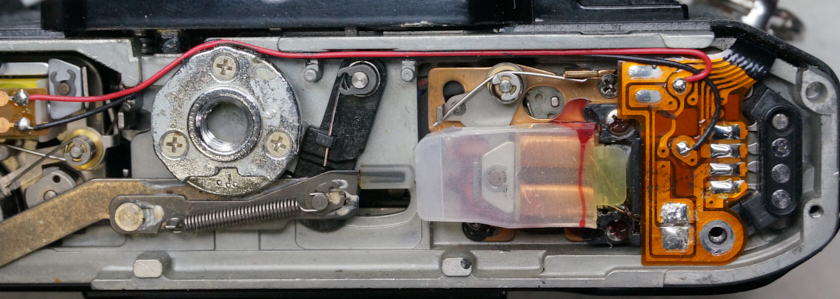So some more broken stuff, a Canon QL17 GIII (again) … I bought this one because it was described as having a problem where the speed was stuck on bulb no matter what it is set on … hmm.
After I got it in my hands I realized that the description was missing a fact … the speed dial could only be turned half way. Well sounds like something is jamming the dial. Time to open it up.
The only difficult part to get deep here is the front lens cell. If you are lucky you can unscrew it with the help of a rubber tool … if you are not, then you need the special Canon tool,
Well, I found the problem … the speed selection dial post is no longer attached, and was jammed against the other dials.
The service manual shows the speed selection dial and the post that engages the speed cam on the shutter (that is lower in the body).
You can see that the top of it is bent … so someone forced the speed dial beyond its limit and popped the rivets holding the post on.
The speed selection dial is designed so that it cannot be over turned unless somebody did that while taking it apart … and I can easily see that this was disassembled before.
Ok, time to straighten it without deforming the rivets. I pressed it back in, then re-expand countersunk rivets with a punch.
Well, that wasn’t so hard … I was lucky that the problem did not involve fixing the shutter (as you cannot access it from just taking the front of the lens apart).







 Make sure the release button is not gummed up.
Make sure the release button is not gummed up. First push up AT dial guard, this will reveal the screw that holds to the body.
First push up AT dial guard, this will reveal the screw that holds to the body.

 Now get to the back.
Now get to the back.
 Unscrew the rewind lever , wrap a little tape, before popping off the e-ring you might want to make deflection wall around it when the ring springs off into infinity. Then you can remove the dial and washer underneath.
Unscrew the rewind lever , wrap a little tape, before popping off the e-ring you might want to make deflection wall around it when the ring springs off into infinity. Then you can remove the dial and washer underneath. Use a rubber grip to remove the ring surrounding the shutter release button. Remove the shutter button, av/tv selector dial, and washer … do not invert camera.
Use a rubber grip to remove the ring surrounding the shutter release button. Remove the shutter button, av/tv selector dial, and washer … do not invert camera. There again is another spring clip, metal washer, selector switch, and finally the multi exposure switch.
There again is another spring clip, metal washer, selector switch, and finally the multi exposure switch. Put some isopropal alchohol on indicator light … then pop off the outer housing pull off
Put some isopropal alchohol on indicator light … then pop off the outer housing pull off The top cover … screws two side, two front, two back … wiggle and slide off, note the wire going to the PC socket.
The top cover … screws two side, two front, two back … wiggle and slide off, note the wire going to the PC socket.
 With a handy-dandy soldering iron you can detach it from the flexiboard. I pulled it out and took a look at it (the plastic cover it a bit of a pain to work around, you might want to cut it.)
With a handy-dandy soldering iron you can detach it from the flexiboard. I pulled it out and took a look at it (the plastic cover it a bit of a pain to work around, you might want to cut it.)